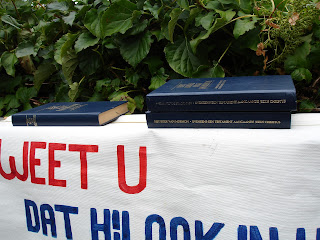Oma’s Pages #48
At last the day of the Big Event arrived.
There was a tea house which is where the bikers were told to stop and have an apple tart and a drink on the weeks of the fietstocht. It is actually a very very old farm and farmhouse that somebody lives and runs as a farm. They just serve tea and apple tarts as a side thing for passers-by.
Thies arranged with the lady that we would rent a large tent with a floor. They cleaned out one of their side barns for us to put displays in. We brought real dishes from the Groningen Church and the Groningen Ward Relief Society served people. The lady provided the food and drinks.
After about an hour of people arriving and visiting the group walked together up the road (which the local city police had closed for the day) to the monument. The monument faces a very small road. There is a large ditch in front of the monument so we had to lay a sort of plank bridge across it. The program sat on the side where the monument was and the people all sat on chairs in the road.
We had hoped there would be 100 people who attended. We optimistically planned for 200 people. We had seating for 123. I went ahead of the group so that I could count them as they came up the road. Since the road was very narrow I knew I could probably get a an accurate count as they came to the chairs. I counted 326 people. We were stunned.
There was a spirit there that cannot be described. I knew that the heavenly members who had been some of the first struggling members of the Church in this country were given the opportunity to be there. I knew that the number of angels that was not seen was much greater than the surprising number we could see.
Because Opa was the Branch President he had been asked to speak. I started to do research about the monument and who spoke at the original dedication of the monument 75 years ago. We were so surprised to learn that Opa Pouwel Van Komen spoke that day as a member of the Groningen Branch which then covered this area as well.
When Thies learned about this fact he staged a picture of the dignitaries in the exactly the same order as the dignitaries 75 years ago with Opa standing in the same place that Pouwel Van Komen stood in 75 years ago. I was overcome with emotion that day.
It was an absolute testimony that God had put us in this place at this time for this reason.






































































